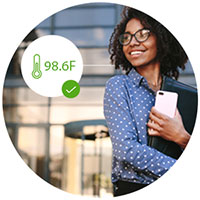
Paxton Net2
Net2 Integrates with Additional Thermal Scanners
Paxton has released an online video tutorial which explains how thermal scanning can help buildings installed with Net2 become more COVID-secure. They have also updated the systems software and have six new thermal scan integrations available to boost installer and end-user flexibility.
The company has been developing solutions throughout 2020 which help reduce the spread of the virus in sites installed with their access control system Net2. While researching relevant updates to give Net2 greater functionality against the current pandemic, Paxton established that thermal scanning upon entry to a site or designated area would be beneficial to monitor people’s well-being, reducing the risk of infection to staff and visitors.
“Currently in the access control industry thermal scanners are seeing a significant rise in demand,” said Steve Rowlands, global product manager at Paxton. “This is due to the symptom commonly associated with the virus, of a consistently high temperature”.
As global scientific evidence suggests, one of the most common symptoms of Coronavirus is a fever with a temperature above 98.6 F. A site being able to detect this is an efficient way to increase their building’s defense against the pandemic and help to meet COVID-secure guidelines. The way in which a site manages the process after detection can be greatly supported by using Net2 access control.
“By using thermal scanning in combination with access control, we are able to further reduce a building’s risk by denying access to people with a heightened temperature,” Rowlands said.
The new thermal scanning integrations compliment Paxton’s recent software updates: Occupancy Management, Flexible Access Permissions, and Checkpoint Control. When these elements are combined, a system administrator can set up designated checkpoints to manage the flow of people and reduce overcrowding as well as maintain social distancing. When monitoring and approving an individual’s well-being, this can be achieved by a manual or automated validation. Checkpoints with thermal scanning detection can also be set up in multiple areas across a site and managed remotely.
“The user presents their physical token, and their temperature is taken simultaneously by the thermal scanner. Access is permitted if their temperature is in the acceptable range and their token is valid,” said Rowlands. Explaining how the thermal scanning process works with Net2. “If a valid token is presented but their temperature is too high - their access is denied. This process takes less than a second and works in conjunction with Net2 access levels and our new series of COVID-secure feature updates”.